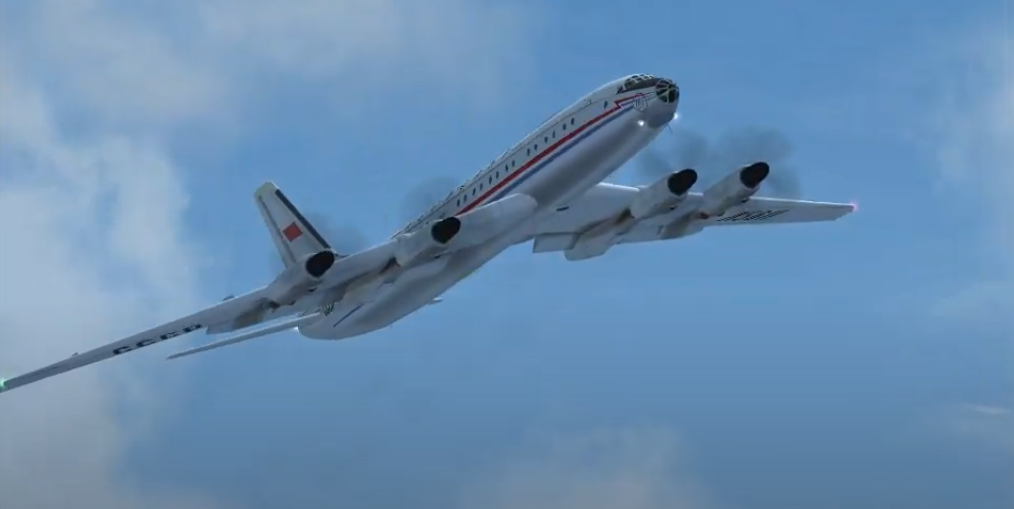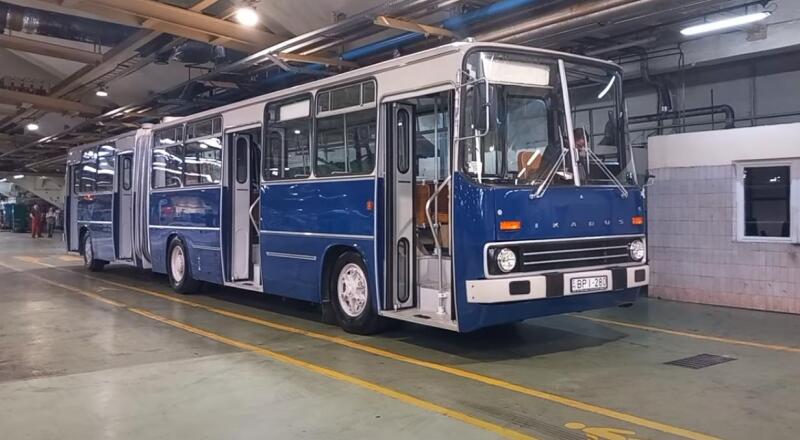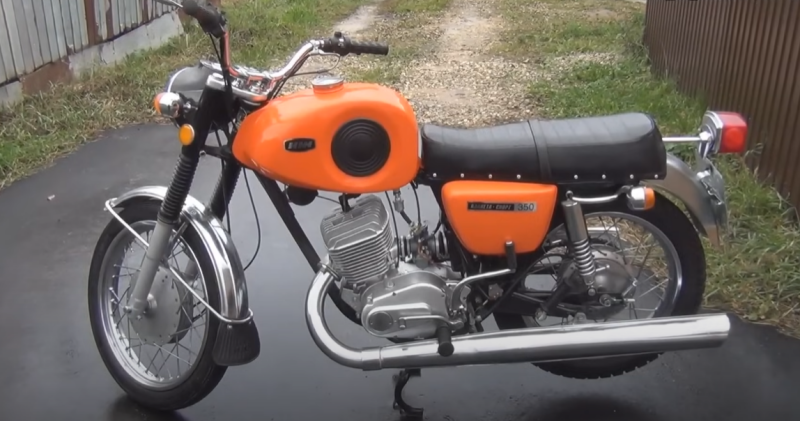The decision to build a long-haul liner
At the end of the 50s, the Soviet Union developed rapidly: many international relations appeared, many countries sought friendship with the USSR, as did the "state of workers and peasants" itself. As a result, there was a need for rapid movement over considerable distances. At that time, there were only two large passenger liners in the Soviet Union - Tu-104 and Il-18.
 The Tu-104 was clearly not suitable for overseas flights. Photo: YouTube.com
The Tu-104 was clearly not suitable for overseas flights. Photo: YouTube.comBut they firmly occupied "their" niche as medium-haul aircraft and could not carry a large number of passengers (more than a hundred people) to other continents.
How a bomber turned into an airliner
As a result, in 1955, the state order of the Tupolev Design Bureau appeared for the creation of an aircraft with a large passenger capacity, capable of making long direct flights. As a base to speed up construction, it was decided to use the ready-made strategic bomber Tu-95. The idea of "retraining" is not new: earlier Tu-16 was made in exactly the same way from the Tu-104. The designed aircraft first received two names: Tu-95P and "product 114" (factory index).
 They began to make a civilian liner out of a military monster. Photo: YouTube.com
They began to make a civilian liner out of a military monster. Photo: YouTube.comA similar "technology" was successfully used in the West. For example, the Boeing-707 was originally supposed to be a tanker.
Despite the fact that the path for the "reissue" of military vehicles had already been beaten, problems arose almost immediately after the start of the "conversion". It would seem, what is so difficult? Cut through the windows, put the chairs and you're done: the bomber has become an airliner. The first thing to be done was to ensure the tightness of the fuselage and its ventilation throughout the entire huge "body" of the aircraft. The number of passengers was well over a hundred, and the flight took place at an altitude of 11 thousand meters. After all, it is not known how 150 people “imprisoned” in a narrow fifty-meter metal pipe will feel - there was no experience in building such ships.
 The fuselage is roomy, but narrow and long. Photo: YouTube.com
The fuselage is roomy, but narrow and long. Photo: YouTube.comSoviet design engineers coped with the problems. But it was not possible to seriously reduce the noise. The problem was “solved” in an original way: tickets to the second salon, closest to which the engines were located, were sold last.
In parallel, the development of turbojet aircraft was carried out. However, such motors were distinguished by excessive "appetite", and safety was lame. Therefore, preference was given to proven TVD (turboprop engines).
Tests, first flights and curiosities
The Tu-114 was made very quickly - it took only a couple of years for test pilot A.P. Yakimov to lift the car into the sky in November 1957 (about a month after the launch of the first artificial Earth satellite). The new airliner was one of the first to have a swept wing with coaxial engines.
 One of the first passenger flights (1958). Photo: YouTube.com
One of the first passenger flights (1958). Photo: YouTube.comSince the plane was originally copied from a bomber, there were some oddities. For example, they automatically “forgot” (more precisely, they didn’t think) to equip a dressing room for the crew of a civilian aircraft: military pilots definitely don’t need it. The toilet was also equipped with only one in the nose (for 150-224 people!). On the first samples, passenger luggage was originally loaded: not at the door, as in all liners, but from below, like bombs into the hatch. The glazed nose is also a legacy of the Tu-95: the navigator had to visually observe the target and therefore he sat in the very “vanguard” of the cockpit.
 In the cockpit (computer simulation). Photo: YouTube.com
In the cockpit (computer simulation). Photo: YouTube.comAnd one more "appendage" from the bomber - a solid height of the car. Because of it, the ladders already available at airports had to be increased.
 A special ladder was made for the Tu-114. Photo: YouTube.com
A special ladder was made for the Tu-114. Photo: YouTube.comAnd yet, the plane eventually became a civilian one. To a large extent, thanks to A. N. Tupolev, who, despite his authority, from the very beginning involved pilots in discussing the test results, listening to their comments. Identified disadvantages were eliminated immediately. One of the technical features of the aircraft is unprecedented efficiency, which was achieved due to the successful combination of the swept wing with the theater. Consumption ranged from 5,6 tons in the first hour of the flight and 4-4,4 tons in the next. For comparison, the Il-62M, released later and comparable in size and weight, consumed at least 7 t / h.
 The Il-62 was less economical than the Tu-114, but it flew faster. Photo: YouTube.com
The Il-62 was less economical than the Tu-114, but it flew faster. Photo: YouTube.comInternational "bride" "issued" in the form of a flight overseas. In 1958 Tu-114 arrived in New York. The dumbfounded Americans could not find either a tractor of adequate power or a suitable gangway. Huge coaxial propellers, wingspan - all this complemented the impression of the power of the new Soviet liner. And in Brazil, the influx of people wishing to inspect the aircraft was so huge that the show lasted for a week, the queues reached two kilometers.
The uniqueness of the internal design
Tu-114 is one of the first aircraft with two decks. At the bottom there was a luggage compartment, cargo, office space, a kitchen (until the beginning of the 60s there was a cook on staff!). the top floor housed the passengers and crew. Between themselves, the decks were connected by an elevator, through which, for example, it was possible to get from the kitchen to the buffet. The maximum capacity of the aircraft was 224 passengers, if the division into classes is eliminated.
 You can get from the first deck to the second on foot. Photo: YouTube.com
You can get from the first deck to the second on foot. Photo: YouTube.comThe passenger cabin is divided into 3 classes. In the "economic" - the usual rows of seats in 3 pieces. In the first class, tables with a lamp were provided (they were removed later). And in the "business lounge" there were compartments, like in a train, designed for three beds!
 Folding tables for 1st class passengers. Photo: YouTube.com
Folding tables for 1st class passengers. Photo: YouTube.comAll this was a fantasy and a miracle for an ordinary Soviet passenger, and for the people as a whole, who had just endured the hardest war in world history.
What did not please the plane to the States?
The liner made a strong impression not only on the ruling elite, but also on ordinary Americans, residents of other states, who enthusiastically greeted the appearance of the Tu-114 at airports. And who will like the demonstration of the power of the enemy state? And all this happened against the backdrop of the Caribbean crisis. The United States used a maximum of diplomatic "moves" to minimize the appearance of the liner in the countries they needed. There were no official prohibitions (as it is now), but suddenly a number of airfields refused to accept the Soviet airliner, motivating this by technical reasons, in particular, by exceeding the load on the runway of 150 tons. The Tu-114 weighed 179 tons.
 Due to its large size and weight, the Soviet airliner was not accepted at all airports. Photo: YouTube.com
Due to its large size and weight, the Soviet airliner was not accepted at all airports. Photo: YouTube.comThe USSR decided to take a chance and sent a turboprop liner on an unprecedented journey from Olenegorsk (Murmansk region) to Cuba. The usual flight through Africa with refueling was banned by the Americans (of course, not directly, bypassing). It was to fly across the Atlantic directly and then along the coast of the United States to the south. When following the Tu-114, the Americans suddenly began to demand a decrease to 1500 m, citing the presence of other aircraft in the echelon. The commander of the ship, Nikolai Tskhovrebov, refused, noting that there was not a single aircraft within the line of sight of 10-12 kilometers, and at a distance of 1,5 km from the ground, his fuel consumption sharply increases. Moreover: the captain demanded to remove other planes from the path, saying that he was the "state board of the USSR." As a result, 16 hours of flight ended safely in Havana.
 One of the surviving Tu-114s at the eternal parking lot in Krivoy Rog. Photo: YouTube.com
One of the surviving Tu-114s at the eternal parking lot in Krivoy Rog. Photo: YouTube.comSince 1957, 31 Tu-114 liners have been produced in series of 3-6 pieces per year. The ship remained in service until 1967, when the jet Il-62 took its place. Today, only 3 copies of the legend remain (in the Russian Federation and Ukraine) in the form of open-air museum exhibits.










